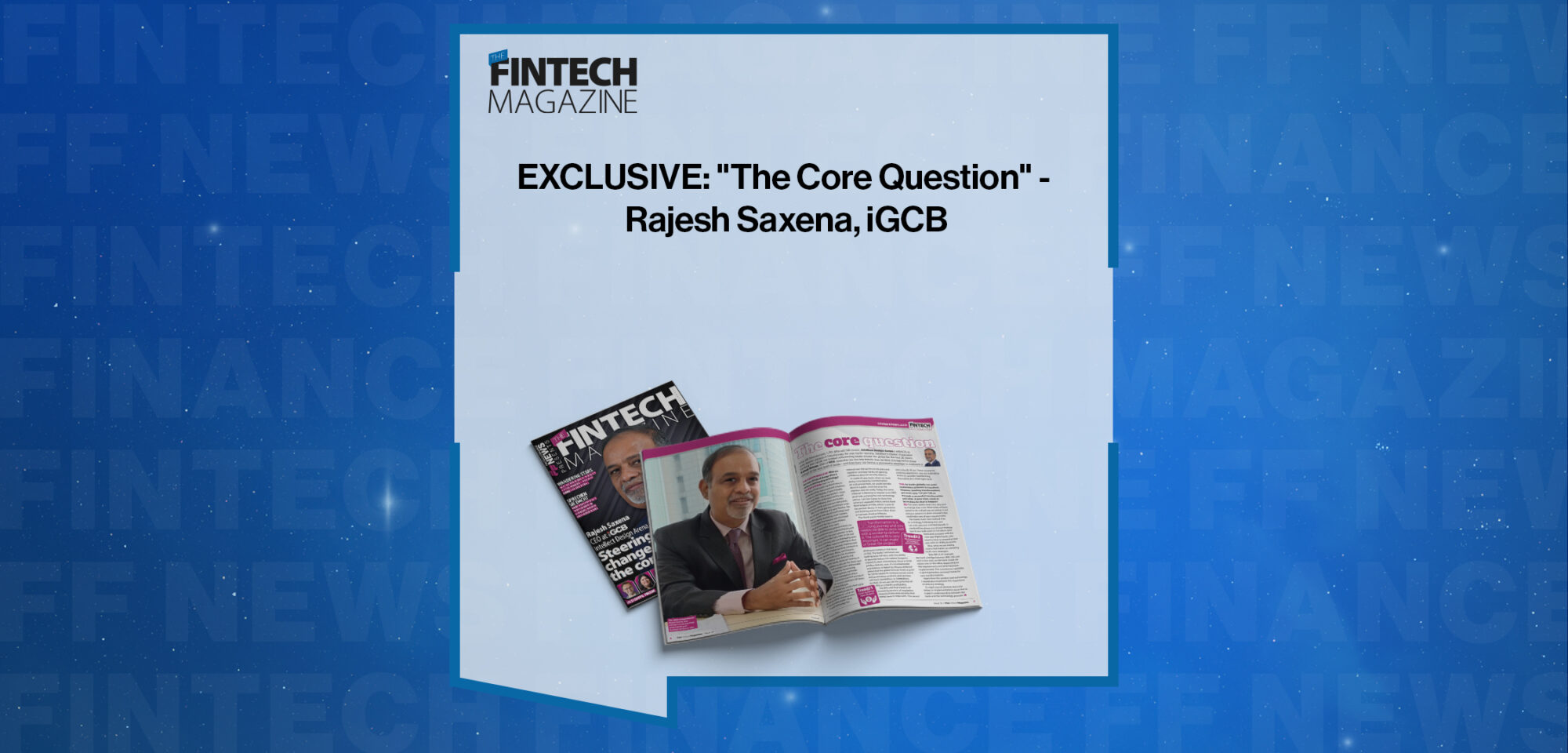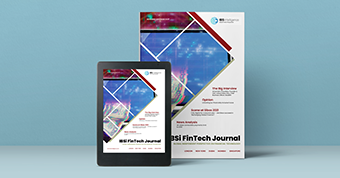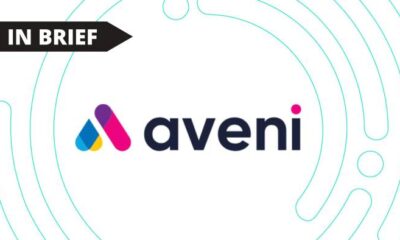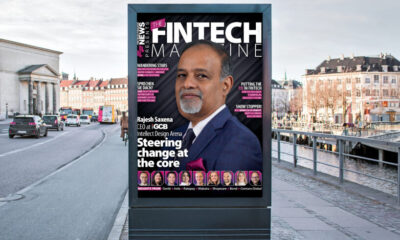Fintech
EXCLUSIVE: “The Core Question” – Rajesh Saxena, iGCB in “The Fintech Magazine”

With 329 microservices, 1,757 APIs, and 535 events, Intellect Design Arena’s eMACH.ai open finance platform is transforming the way banks operate. Intellect’s Global Consumer Banking unit (iGCB) has worked with major banks around the world for the past 30 years. Rajesh Saxena, CEO of iGCB, outlines the five key trends that he believes are driving technological change at the heart of banks and how banks can devise a successful strategy to embrace them
THE FINTECH MAGAZINE: What are the main drivers of change regarding core banking technology?
RAJESH SAXENA: Over the last 365 days I have spent a lot of time understanding the needs and ambitions of customers in our key markets. I’ve probably met more than 100 senior bankers. I concluded that while every country and every customer is different, there are some common trends and common pain points
The first trend that is gaining momentum is the rise of open banking and open finance. The wave started with the UK and Europe and is now required by most markets. The Middle East has also seen increased traction in the last couple of years. Integrating an open finance-enabled ecosystem into a bank can deliver contextual and curated solutions and experiences for the end customer. Indeed, iGCB has clients such as Cater Allen in the UK and OTTO in Germany who are leveraging open finance to offer superior banking services to their customers. We have similarly implemented open finance-enabled banking solutions in APAC, Middle East, Africa and Oceania.
The second trend is growing competition from fintechs and other banks. Banks are looking for options to disrupt the status quo and increase their addressable market by moving from a product provider to a marketplace where customers can find a product or service that fits all aspects of their lifestyle.
The third key trend, on which iGCB has been advising banks in recent years, is the use of the cloud, whether private or, in some cases, even public. Cloud technology has matured over the last five to six years, and regulators and large banks are gaining confidence in its security aspects.
A couple of years ago, when we were doing a core banking transformation for a private bank in the UK, we couldn’t take it to a public cloud because the regulator wasn’t ready. Today, the same customer is planning to migrate to an AWS cloud and we are the primary technology partner. I’m also happy to share that we just upgraded the Indian central bank Reserve Bank of India, which is one of our major customers, to next-generation core banking and brought them to a private cloud on VMware.
“Transformation is a long journey and you need to be able to collaborate well with a supplier to make it happen. Cultural adaptation is very important. It can make or break the project”
The fourth trend, found especially in developed markets, is the focus on ESG. Bank customers aim to achieve net zero, with the ability to green/reduce the carbon footprint created by their transactions. Once a feature of a niche product, today it is a fundamental requirement. A report by Alvarez & Marsal says the global annual revenue pool for banks related to environmental, social and governance products and services will reach 295 billion euros, or $300 billion, by 2030. We can therefore see the potential of ESG on a bank’s profitability.
The fifth and final trend is increasing privacy and security regulation that banks must contend with. The most recent one is the EU AI Act. These evolving regulations are also motivating banks to consider transforming into a
more agile bank.
TFM: So banks globally are under enormous pressure to transform. However, banking transformations are never easy. Can you walk us through a successful transformation and what you think needs to be in place for this to happen?
RS: For years banks have been very reluctant to change their core. What most of them chose to do instead was empty it and put systems in place around it that could take care of the parties’ requirements. But banks have now understood that, as a strategy, emptying the core can only provide limited benefits. It may still be phase one of your strategy, but if you really want to transform your bank and compete with new age digital banks, you need to have a global core with the ability to evolve.
Furthermore, what we are seeing now is that banks are adopting multi-core strategies. Let’s take RBI as an example.
We built a bridge between the old RBI core and a new core, so that the bank could use one or the other, depending on the requirements and what had been implemented. This ability to coexist is gaining traction among banks for fundamental transformations. In addition to product and technology, I would also like to highlight the importance of delivery strategy. It might seem obvious, but most delays in implementations occur due to a gap in understanding between the bank and the technology provider
As a partner in the bank’s transformation journey, we not only create a comprehensive plan, but also carry out detailed design thinking sessions with each client to create an implementation plan that focuses on the bank’s stated and unstated needs and prioritizes business impact. We are further building regional delivery teams to work more closely with banks. Strategies like these are further reducing the risk of major transformations.
TFM: So how do you create a powerful core? Are there some architectural principles a CIO should consider?
RS: I strongly suggest that banks invest in a complete core consisting of events, microservices, APIs, cloud, headless architecture and embedded AI use cases. The intellect is the first to bring together all these elements. At Intellect we call it eMACH.ai. We’ve moved our entire architecture to eMACH.ai so that the APIs, microservices, and events are all open. It is completely born on the cloud and this gives banks the ability to integrate, expand and connect with ecosystem players. We have also created a “country-ready” ecosystem for several countries, reducing the go-to-market for banks.
Most of our competitors are now in the process of moving from a monolithic architecture to this type of advanced infrastructure. Our investment in eMACH.ai offers us significant benefits and puts us at the forefront. But it’s not just a question of architecture. Intellect’s sweet spot as a company is between domain and technology. Intellect’s talent comes from deep banking experience, and that really helps, because simply providing banks with a technology framework, as some of our competitors do, is not enough.
We have depth and breadth in the financial services industry. From lending to origination, from savings accounts to checking accounts, we are able to offer a complete platform, built on the same architecture. Furthermore, we co-create and co-innovate with banks, and this also helps in the transformation journey. We have seen significant success with the co-creation and co-innovation model with our clients in Africa.
TFM: You say that one of the things that sets you apart and one of the reasons you’ve been successful in some of the transformations you’ve implemented at various banks is that you only work in this space. Can you give an example of how this helps?
RS: Coming from the banking sector, I know that financial services is not a simple field, it requires deep understanding. Companies that are horizontal in nature will not be able to bring the vertical depth of knowledge needed.
I’ll give you an example that has to do with artificial intelligence.
Today, AI is at the forefront of every conversation, even in banking. When we talk to people about AI, most of them, because they use Microsoft Windows, will have an Azure Copilot bundled with them. But having horizontal AI playing this way isn’t enough. What you really need to know is how to use AI to create, for example, an underwriting use case, an asset use case, or an enterprise use case.
“Intellect’s sweet spot as a company is between domain and technology. Intellect’s talent comes from deep banking experience, because providing banks with just a technological framework is not enough”
Our credit-focused Gen AI solution has created a buzz in the market with its underwriting capabilities. These vertical domain use cases are key and that’s why I firmly believe that companies like ours, with an exclusive focus on banking and 30 years of experience transforming Tier 1 banks around the world, add a significant value.
TFM: This year iGCB is a sponsor of Money20/20 Europe. Can you tell us more about the products you will focus on there?
RS: Money20/20 is a flagship event for iGCB. This year we will focus on three things in particular.
One is our digital engagement platform, which is one common platform for the retail customer, the SMB customer and the enterprise customer. If you’re a Tier 2 or Tier 3 bank with a strong retail business and a moderately sized retail business, you don’t need two portals, because two portals are huge expenses and involve a huge amount of work. So we created a common no-code platform for both.
The advantage of no-code is that the bank itself can make changes digitally, because time to market is very important. We believe the digital engagement platform could be a game changer for banks around the world, including European banks still using legacy digital banking. At Money20/20 we will also show how we can help banks implement dual-core strategy, our Gen AI platform built for banks and our digital lending suite, iKredit 360.
TFM: So, in conclusion, what would be your advice for banks looking to implement a successful transformation?
RS: I can’t stress enough the importance of choosing an open finance-enabled, fully cloud-native platform. A platform will be with you for the next 8-15 years, depending on your appetite, right?
So you definitely need to choose one that has the latest architecture and is completely cloud-native, not just “cloud-ready” or “cloud-enabled”. The second thing I would say is that transformation is a long journey and you have to be able to work well with a supplier to make it happen. So the cultural fit of your organization with the supplier is very important. It can make or break the project.
Finally, in my opinion, transformation must be driven from the top. Sometimes we’ve seen it led by a bank’s technology group. Sometimes it is driven by the corporate group. And sometimes there is friction between these two. But it needs to be both a business and technology agenda. For this purpose all parties must be united. You can have a great product, but if the culture, the team, the agile working and the buy-in from both the business and technology groups aren’t there, it won’t be as successful as it could be.
This article was published in The Fintech Magazine, issue 32, pages 6-7
Fintech
US Agencies Request Information on Bank-Fintech Dealings

Federal banking regulators have issued a statement reminding banks of the potential risks associated with third-party arrangements to provide bank deposit products and services.
The agencies support responsible innovation and banks that engage in these arrangements in a safe and fair manner and in compliance with applicable law. While these arrangements may offer benefits, supervisory experience has identified a number of safety and soundness, compliance, and consumer concerns with the management of these arrangements. The statement details potential risks and provides examples of effective risk management practices for these arrangements. Additionally, the statement reminds banks of existing legal requirements, guidance, and related resources and provides insights that the agencies have gained through their oversight. The statement does not establish new supervisory expectations.
Separately, the agencies requested additional information on a broad range of arrangements between banks and fintechs, including for deposit, payment, and lending products and services. The agencies are seeking input on the nature and implications of arrangements between banks and fintechs and effective risk management practices.
The agencies are considering whether to take additional steps to ensure that banks effectively manage the risks associated with these different types of arrangements.
SUBSCRIBE TO THE NEWSLETTER
And get exclusive articles on the stock markets
Fintech
What changes in financial regulation have impacted the development of financial technology?

Exploring the complex landscape of global financial regulation, we gather insights from leading fintech leaders, including CEOs and finance experts. From the game-changing impact of PSD2 to the significant role of GDPR in data security, explore the four key regulatory changes that have reshaped fintech development, answering the question: “What changes in financial regulation have impacted fintech development?”
- PSD2 revolutionizes access to financial technology
- GDPR Improves Fintech Data Privacy
- Regulatory Sandboxes Drive Fintech Innovation
- GDPR Impacts Fintech Data Security
PSD2 revolutionizes access to financial technology
When it comes to regulatory impact on fintech development, nothing comes close to PSD2. This EU regulation has created a new level playing field for market players of all sizes, from fintech startups to established banks. It has had a ripple effect on other markets around the world, inspiring similar regulatory frameworks and driving global innovation in fintech.
The Payment Services Directive (PSD2), the EU law in force since 2018, has revolutionized the fintech industry by requiring banks to provide third-party payment providers (TPPs) with access to payment services and customer account information via open APIs. This has democratized access to financial data, fostering the development of personalized financial instruments and seamless payment solutions. Advanced security measures such as Strong Customer Authentication (SCA) have increased consumer trust, pushing both fintech companies and traditional banks to innovate and collaborate more effectively, resulting in a dynamic and consumer-friendly financial ecosystem.
The impact of PSD2 has extended beyond the EU, inspiring similar regulations around the world. Countries such as the UK, Australia and Canada have launched their own open banking initiatives, spurred by the benefits seen in the EU. PSD2 has highlighted the benefits of open banking, also prompting US financial institutions and fintech companies to explore similar initiatives voluntarily.
This has led to a global wave of fintech innovation, with financial institutions and fintech companies offering more integrated, personalized and secure services. The EU’s leadership in open banking through PSD2 has set a global standard, promoting regulatory harmonization and fostering an interconnected and innovative global financial ecosystem.
Looking ahead, the EU’s PSD3 proposals and Financial Data Access (FIDA) regulations promise to further advance open banking. PSD3 aims to refine and build on PSD2, with a focus on improving transaction security, fraud prevention, and integration between banks and TPPs. FIDA will expand data sharing beyond payment accounts to include areas such as insurance and investments, paving the way for more comprehensive financial products and services.
These developments are set to further enhance connectivity, efficiency and innovation in financial services, cementing open banking as a key component of the global financial infrastructure.
General Manager, Technology and Product Consultant Fintech, Insurtech, Miquido
GDPR Improves Fintech Data Privacy
Privacy and data protection have been taken to another level by the General Data Protection Regulation (GDPR), forcing fintech companies to tighten their data management. In compliance with the GDPR, organizations must ensure that personal data is processed fairly, transparently, and securely.
This has led to increased innovation in fintech towards technologies such as encryption and anonymization for data protection. GDPR was described as a top priority in the data protection strategies of 92% of US-based companies surveyed by PwC.
Financial Expert, Sterlinx Global
Regulatory Sandboxes Drive Fintech Innovation
Since the UK’s Financial Conduct Authority (FCA) pioneered sandbox regulatory frameworks in 2016 to enable fintech startups to explore new products and services, similar frameworks have been introduced in other countries.
This has reduced the “crippling effect on innovation” caused by a “one size fits all” regulatory approach, which would also require machines to be built to complete regulatory compliance before any testing. Successful applications within sandboxes give regulators the confidence to move forward and address gaps in laws, regulations, or supervisory approaches. This has led to widespread adoption of new technologies and business models and helped channel private sector dynamism, while keeping consumers protected and imposing appropriate regulatory requirements.
Co-founder, UK Linkology
GDPR Impacts Fintech Data Security
A big change in financial regulations that has had a real impact on fintech is the 2018 EU General Data Protection Regulation (GDPR). I have seen how GDPR has pushed us to focus more on user privacy and data security.
GDPR means we have to handle personal data much more carefully. At Leverage, we have had to step up our game to meet these new rules. We have improved our data encryption and started doing regular security audits. It was a little tricky at first, but it has made our systems much more secure.
For example, we’ve added features that give users more control over their data, like simple consent tools and clear privacy notices. These changes have helped us comply with GDPR and made our customers feel more confident in how we handle their information.
I believe that GDPR has made fintech companies, including us at Leverage, more transparent and secure. It has helped build trust with our users, showing them that we take data protection seriously.
CEO & Co-Founder, Leverage Planning
Related Articles
Fintech
M2P Fintech About to Raise $80M

Application Programming Interface (API) Infrastructure Platform M2P Financial Technology has reached the final round to raise $80 million, at a valuation of $900 million.
Specifically, M2P Fintech, formerly known as Yap, is closing a new funding round involving new and existing investors, according to entrackr.com. The India-based company, which last raised funding two and a half years ago, previously secured $56 million in a round led by Insight Partners, earning a post-money valuation of $650 million.
A source indicated that M2P Fintech is ready to raise $80 million in this new funding round, led by a new investor. Existing backers, including Insight Partners, are also expected to participate. The new funding is expected to go toward enhancing the company’s technology infrastructure and driving growth in domestic and international markets.
What does M2P Fintech do?
M2P Fintech’s API platform enables businesses to provide branded financial services through partnerships with fintech companies while maintaining regulatory compliance. In addition to its operations in India, the company is active in Nepal, UAE, Australia, New Zealand, Philippines, Bahrain, Egypt, and many other countries.
Another source revealed that M2P Fintech’s valuation in this funding round is expected to be between USD 880 million and USD 900 million (post-money). The company has reportedly received a term sheet and the deal is expected to be publicly announced soon. The Tiger Global-backed company has acquired six companies to date, including Goals101, Syntizen, and BSG ITSOFT, to enhance its service offerings.
According to TheKredible, Beenext is the company’s largest shareholder with over 13% ownership, while the co-founders collectively own 34% of the company. Although M2P Fintech has yet to release its FY24 financials, it has reported a significant increase in operating revenue. However, this growth has also been accompanied by a substantial increase in losses.
Fintech
Scottish financial technology firm Aveni secures £11m to expand AI offering

By Gloria Methri
Today
- To come
- Aveni Assistance
- Aveni Detection
Artificial intelligence Financial Technology Aveni has announced one of the largest Series A investments in a Scottish company this year, amounting to £11 million. The investment is led by Puma Private Equity with participation from Par Equity, Lloyds Banking Group and Nationwide.
Aveni combines AI expertise with extensive financial services experience to create large language models (LLMs) and AI products designed specifically for the financial services industry. It is trusted by some of the UK’s leading financial services firms. It has seen significant business growth over the past two years through its conformity and productivity solutions, Aveni Detect and Aveni Assist.
This investment will enable Aveni to build on the success of its existing products, further consolidate its presence in the sector and introduce advanced technologies through FinLLM, a large-scale language model specifically for financial services.
FinLLM is being developed in partnership with new investors Lloyds Banking Group and Nationwide. It is a large, industry-aligned language model that aims to set the standard for transparent, responsible and ethical adoption of generative AI in UK financial services.
Following the investment, the team developing the FinLLM will be based at the Edinburgh Futures Institute, in a state-of-the-art facility.
Joseph Twigg, CEO of Aveniexplained, “The financial services industry doesn’t need AI models that can quote Shakespeare; it needs AI models that deliver transparency, trust, and most importantly, fairness. The way to achieve this is to develop small, highly tuned language models, trained on financial services data, and reviewed by financial services experts for specific financial services use cases. Generative AI is the most significant technological evolution of our generation, and we are in the early stages of adoption. This represents a significant opportunity for Aveni and our partners. The goal with FinLLM is to set a new standard for the controlled, responsible, and ethical adoption of generative AI, outperforming all other generic models in our select financial services use cases.”
Previous Article
Network International and Biz2X Sign Partnership for SME Financing
IBSi Daily News Analysis

SMBs Leverage Cloud to Gain Competitive Advantage, Study Shows
IBSi FinTech Magazine

- The Most Trusted FinTech Magazine Since 1991
- Digital monthly issue
- Over 60 pages of research, analysis, interviews, opinions and rankings
- Global coverage
subscribe now
-

 DeFi11 months ago
DeFi11 months agoDeFi Technologies Appoints Andrew Forson to Board of Directors
-

 Fintech11 months ago
Fintech11 months agoUS Agencies Request Information on Bank-Fintech Dealings
-

 News12 months ago
News12 months agoBlock Investors Need More to Assess Crypto Unit’s Earnings Potential, Analysts Say — TradingView News
-

 DeFi11 months ago
DeFi11 months agoSwitchboard Revolutionizes DeFi with New Oracle Aggregator
-

 DeFi11 months ago
DeFi11 months agoIs Zypto Wallet a Reliable Choice for DeFi Users?
-

 News12 months ago
News12 months agoBitcoin and Technology Correlation Collapses Due to Excess Supply
-

 Fintech11 months ago
Fintech11 months agoWhat changes in financial regulation have impacted the development of financial technology?
-

 Fintech11 months ago
Fintech11 months agoScottish financial technology firm Aveni secures £11m to expand AI offering
-

 Fintech11 months ago
Fintech11 months agoScottish financial technology firm Aveni raises £11m to develop custom AI model for financial services
-

 News1 year ago
News1 year agoValueZone launches new tools to maximize earnings during the ongoing crypto summer
-

 Videos5 months ago
Videos5 months ago“Artificial intelligence is bringing us to a future that we may not survive” – Sco to Whitney Webb’s Waorting!
-

 DeFi1 year ago
DeFi1 year agoTON Network Surpasses $200M TVL, Boosted by Open League and DeFi Growth ⋆ ZyCrypto


















